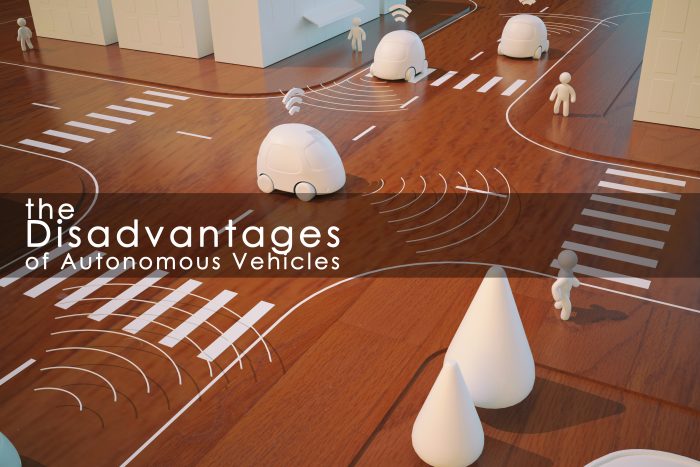The Downside of Driverless

What are some of the disadvantages of switching to autonomous vehicles?
In 2009, Google began secretly developing fully-autonomous cars. Since then, these cars have driven more than 2,000,000 miles on the roads. The idea of driverless cars has exploded since its origin, sparking ongoing debates about the safety of these cars.
The idea is to keep drivers safe and prevent accidents; coming from the fact that over 90% of accidents are the driver’s fault. However, there are many factors that go into whether or not driverless cars are actually safe.
We live in a world where humans control technology; autonomous cars gives the power of control to technology. Riding in a driverless car ultimately puts your life in the hands of a computer. This idea sits well with some; others, not so much.
I want to focus on the disadvantages of giving so much power to technology.
What are the disadvantages of driverless vehicles?
- The price of these vehicles. In the beginning, autonomous vehicles are going to be too expensive for the average person to buy. How will autonomous vehicles going to replace the traditional vehicles if they are unaffordable to the majority of people?
- If not everyone can afford to purchase an autonomous car, this leaves the roads scattered with both traditional vehicles and autonomous. This is a potentially danger concept, which could lead to tragic accidents.
- The rise of self-driving cars leaves hundreds of thousands of people out of jobs. Taxi drivers, food delivery drivers, truck drivers, This could impact families across America.
- Weather is always unpredictable. How can there be efficient technology that can adjust to weather conditions, if the conditions are never the same?
- Hackers. Hackers could hijack the system and take control of the car, causing a deadly accident. If hacking happens with any other device, what’s in the way of a criminal hacking the computer’s system?
- Who’s at fault in an accident? This is extremely important. If the computer is driving the car and causes an accident, who pays for it? The company who created the technology running the car? Or the owner of the car?
- We will lose our ability to drive. Remember when you first started driving? Driving under certain conditions was terrifying due to the lack of experience. If an issue were to occur with the autonomous vehicle, it’s possible humans would lack the ability to drive.
- There’s a sense of freedom in being able to drive. What would the world be like if we could no longer experience the calming sense of euphoria that comes with the natural task of driving?
- The technology would have to take into consideration every random occurrence that could take place. Pedestrians illegally jay-walk, even on dark nights where there isn’t a crosswalk. This specific incident has already caused a death with an autonomous car. What’s stopping it from happening again?
- Pedestrians and bicyclists use hand signals to indicate which way they are going, etc. The technology would have to have to ability to comprehend every hand signal that a human could naturally read.
- Loss of control of our fate. It brings some of us a sense of contentment to know that our is in our hands. We are in control. We are alert, aware, and know which moves to make next. Although the driverless cars are safe some of the time, it’s possible something could go wrong, leaving us without full control of what happens.
- Road systems would need to change. This would take time and a lot of it. We would need to be better prepared before the use of autonomous cars on our roads could be considered safe.
The plan to bring autonomous cars on the road escalated way too quickly. With proper planning, we shouldn’t have had to lose the lives of human beings due to these cars being on the road.
Do you have questions about your insurance? Find an insurance agent near you with our Agent Finder
Search All Blogs
Search All Blogs
Read More Blogs
Cozying Up: Embracing the Danish Art of Hygge for a Stress-Free December
Banish the December chaos! A simple guide to adopting Hygge—the Danish concept of cozy contentment—for a truly joyful holiday season.
Tinsel, Traffic, and Transactions: Insuring Your Business Against December’s Holiday Rush Risks
Don’t let the holiday rush expose your business. A guide to essential commercial insurance coverages for increased sales, foot traffic, and cyber threats in December.
The Ultimate December Gift: Why Life Insurance is the Most Important Present You’ll Ever Give
Forget the gadgets; life insurance is the real gift of security. A timely look at protecting your family’s future during the season of giving.
Skids, Slush, and Safety: How Your Auto Insurance Navigates the December Driving Nightmare
Essential auto insurance checks and tips for safe, claim-free driving through December’s challenging winter weather and holiday traffic.
Snowed In, Safely Covered: A December Guide to Home Insurance and Winter Preparedness
Don’t let winter woes ruin your holiday cheer. Essential tips on home insurance coverage for snow, ice, and festive accidents.
The Mindful Feast: Reclaiming Thanksgiving in a World of Distraction
Want a more peaceful Thanksgiving? Learn how to embrace a mindful approach and find true gratitude this year.
The New Entrepreneur’s Playbook: Insuring Your Business for Digital and Global Risks in 2026
Starting a digital-first business? Learn how to protect your enterprise from modern risks in 2026.
The Modern Parent’s Dilemma: Life Insurance for a Generation of Savers and Investors
Today’s parents have new financial goals. Here’s how life insurance can be a flexible tool for a modern family in 2026.
The Gig Economy Driver: Navigating Auto Insurance for Side Hustles in 2026
Driving for a gig app? Your personal auto insurance might not cover you. Learn how to get the right coverage in 2026.
The Modern Homeowner’s Guide to Water Damage: The Hidden Risk of 2026
Water damage is a growing threat to your home. Learn how to prevent it and protect your insurance in 2026.










